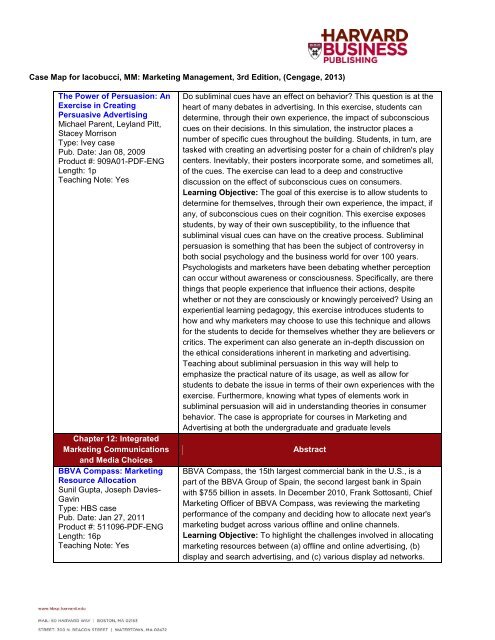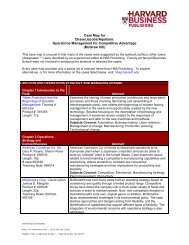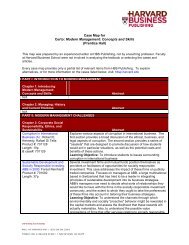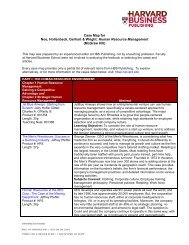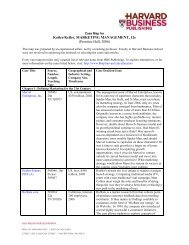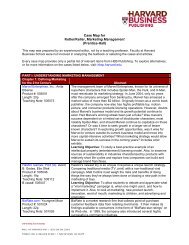Marketing Management, 3rd Edition - Harvard Business School Press
Marketing Management, 3rd Edition - Harvard Business School Press
Marketing Management, 3rd Edition - Harvard Business School Press
Create successful ePaper yourself
Turn your PDF publications into a flip-book with our unique Google optimized e-Paper software.
Case Map for Iacobucci, MM: <strong>Marketing</strong> <strong>Management</strong>, <strong>3rd</strong> <strong>Edition</strong>, (Cengage, 2013)<br />
The Power of Persuasion: An<br />
Exercise in Creating<br />
Persuasive Advertising<br />
Michael Parent, Leyland Pitt,<br />
Stacey Morrison<br />
Type: Ivey case<br />
Pub. Date: Jan 08, 2009<br />
Product #: 909A01-PDF-ENG<br />
Length: 1p<br />
Teaching Note: Yes<br />
Chapter 12: Integrated<br />
<strong>Marketing</strong> Communications<br />
and Media Choices<br />
BBVA Compass: <strong>Marketing</strong><br />
Resource Allocation<br />
Sunil Gupta, Joseph Davies-<br />
Gavin<br />
Type: HBS case<br />
Pub. Date: Jan 27, 2011<br />
Product #: 511096-PDF-ENG<br />
Length: 16p<br />
Teaching Note: Yes<br />
Do subliminal cues have an effect on behavior? This question is at the<br />
heart of many debates in advertising. In this exercise, students can<br />
determine, through their own experience, the impact of subconscious<br />
cues on their decisions. In this simulation, the instructor places a<br />
number of specific cues throughout the building. Students, in turn, are<br />
tasked with creating an advertising poster for a chain of children's play<br />
centers. Inevitably, their posters incorporate some, and sometimes all,<br />
of the cues. The exercise can lead to a deep and constructive<br />
discussion on the effect of subconscious cues on consumers.<br />
Learning Objective: The goal of this exercise is to allow students to<br />
determine for themselves, through their own experience, the impact, if<br />
any, of subconscious cues on their cognition. This exercise exposes<br />
students, by way of their own susceptibility, to the influence that<br />
subliminal visual cues can have on the creative process. Subliminal<br />
persuasion is something that has been the subject of controversy in<br />
both social psychology and the business world for over 100 years.<br />
Psychologists and marketers have been debating whether perception<br />
can occur without awareness or consciousness. Specifically, are there<br />
things that people experience that influence their actions, despite<br />
whether or not they are consciously or knowingly perceived? Using an<br />
experiential learning pedagogy, this exercise introduces students to<br />
how and why marketers may choose to use this technique and allows<br />
for the students to decide for themselves whether they are believers or<br />
critics. The experiment can also generate an in-depth discussion on<br />
the ethical considerations inherent in marketing and advertising.<br />
Teaching about subliminal persuasion in this way will help to<br />
emphasize the practical nature of its usage, as well as allow for<br />
students to debate the issue in terms of their own experiences with the<br />
exercise. Furthermore, knowing what types of elements work in<br />
subliminal persuasion will aid in understanding theories in consumer<br />
behavior. The case is appropriate for courses in <strong>Marketing</strong> and<br />
Advertising at both the undergraduate and graduate levels<br />
Abstract<br />
BBVA Compass, the 15th largest commercial bank in the U.S., is a<br />
part of the BBVA Group of Spain, the second largest bank in Spain<br />
with $755 billion in assets. In December 2010, Frank Sottosanti, Chief<br />
<strong>Marketing</strong> Officer of BBVA Compass, was reviewing the marketing<br />
performance of the company and deciding how to allocate next year's<br />
marketing budget across various offline and online channels.<br />
Learning Objective: To highlight the challenges involved in allocating<br />
marketing resources between (a) offline and online advertising, (b)<br />
display and search advertising, and (c) various display ad networks.


